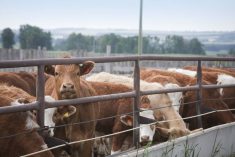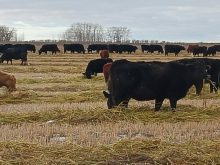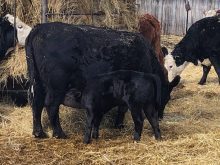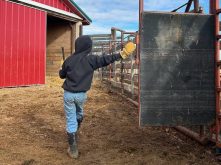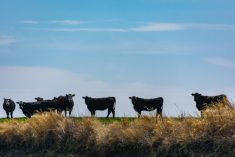The beginning of a New Year marks a good time to work on planning for the year ahead. I believe we should be planning for “Profitivity” on our farms and ranches.
Profitivity is a combination of profitability, productivity and positivity. For an operation to thrive, these three things are important to get right. Profit and production may be somewhat self-explanatory, but planning for a positive attitude is also essential. There is very little point in planning in a negative direction or ranching just for ranching’s sake.
Read Also

Harvest wraps up and fall work begins
At the Eppich famly ranch in western Saskatchewan, the fall harvest was successful with few breakdowns, cows and calves have been sorted and a new tractor has arrived
Being accountable for the Profitivity triad is a challenge. Most of us in production agriculture like the production piece. Seeing new calves up and running, smelling fresh-cut hay, or seeing a pen of steers blossom is very gratifying, but production is not enough. In order of profitivity importance, I would probably place positivity first, profit second and productivity in third place.
I sincerely think it is important and OK to ask some basic questions about our farms and ranches. “Is this place fun?” or, put another way, “If I saw a job posting for our operation, would I want to work there?”
Building a positive end goal or vision for the ranch and the ranch team (even if it is a team of one) and for life is a key first step in the planning process, and it is probably the hardest. There are a few really good resources for this, but one of my favourite places to start is with Simon Sinek and his book Start With Why. If you are not a reader, just search him up on Google, YouTube or your favourite podcast supplier.
On a more personal level, if the positivity challenge is an internal struggle, resources such as Do More Ag are extremely valuable. It is nearly impossible to build a positive business if you are going through personal struggles and feel you don’t have a place to turn to for help.
Profit planning is lodged firmly in spot No. 2. Understanding how much money you want to net at the end of the year and what you want to do with that money is a good framework for creating effectiveness.
Planning for profit will also help to focus the production equations. Rather than going through the motions of production and hoping to make money, profit planning clearly defines what we should be doing, rather than what we want to be doing.
Is this investment or input going to move us toward our goal? Is the profit goal realistic given our operational size? What obvious things am I missing? There are a lot of good profit planning tools out there, but a basic understanding of your costs is a great first step. How much are my direct costs (things that physically go into the cow) to run a cow? What are your total overhead costs?
Once we make a profit decision, the next step is to look at the production side. Is the profit I want achievable with our operation? What production levels will support my profit goal? What production costs should I invest in? Do I have the right production system or am I producing the right things?
Diminishing returns
A simple tangible example could be creep feeding. Creep feeding obviously helps to increase weaning weight and potential revenues from weaned calf sales. Creep feeding is also obviously not free, as there are feed and labour costs involved. Whether creep feeding is a good or bad production decision should be balanced against the net benefit and your profit goals.
The other key part of the productivity piece is to make sure we are measuring the right production measures. Are we concerned with production per acre? Or per cow? Are there other things we are concerned about in terms of production, like disease risk, or ecological function? Or measuring if we are effective or not? How much time do I invest and for what return? Am I completely played out and still falling behind? Do we measure things like our time in our operation?
Over the years I’ve learned it is essential to place positivity first and the best investment on a farm or ranch is nearly always investing in the people, but I would firmly place profit ahead of production. It’s interesting to me that while giving presentations on our own operation I often run into the dichotomy of production versus profit.
We tend to be a lower-cost type of producer, but I get a lot of questions about our productivity. While this likely means I have done a poor job of explaining what we do, I think it’s fair to say traditional ideas of production do not always equate to profit and profit may not equate to production, but the two are intertwined. There is often a stereotype that operations that are not extremely productive — for example, weaning heavy calves — are not profitable. The reality is that this may or may not be true.
A basic economic theory driving the production/profit paradigm is that of diminishing returns. This means that for each level of input we will see rising output to a certain point, but past that point each unit of input will progressively yield a lower return on investment. Stated another way, there is a reason we don’t feed 90 pounds of hay per day to a cow. The first 40 pounds is effective and the last 50 pounds are a waste.
Planning for profitivity means understanding your profit goals and your production system and perhaps more importantly measuring the right production, profit and attitude. We may not wean 800-pound calves, but our pastures are highly productive. What drives your profit equation, and does it fit your production?
Having a positive goal and outlook and a profit orientation also makes it easier to be accountable for doing some of those should versus want to jobs, as with planning you can better see how those less fun jobs move you toward your positive goals. It also allows you the mental freedom to quit doing ineffective tasks.
While I have described profitivity in a somewhat linear fashion, it is actually a circular process of planning and replanning. If production cannot meet my profit goal, or my profit goals don’t support my life goals, we need to recirculate through the problem and find a frame of reference and a plan that does work.
Deliberate profitivity planning can create businesses that have effective production, produce profits and create happiness amongst families and employees. Identifying weak points and addressing them through the process can strengthen businesses and lives. Every operation is unique, and every operation will have a different profitivity plan, but working on and in a business that is fun, productive and profitable generally reinforces the positive feedback loop.




